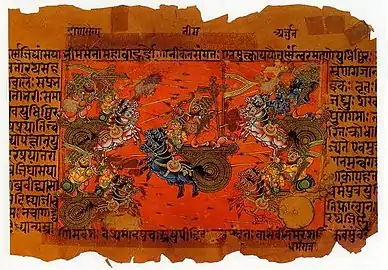Ahilawati
Ahilāvati, also known as Mourvi, her maiden name, was a female figure in the Mahābhārata epic. She was also known as Kamkanthika. She was a Nāga Kanyā[1] (meaning snake-girl) and was married to Ghatotkacha. Her father was Mura, an ally of Naraka. Shri Krishna, along with his wife Satyabhama went to defeat Narakasura after he stole God Varuna's umbrella and Goddess Aditi's earrings. First she fought with Satyabhama. After Shri Krishna killed Narakasura, he killed Maurvi's father, Mura. Mauravi decided to avenge her father's death. However, Shri Krishna stopped her and told her that soon she would get married.
| Mauravi (Ahilawati) | |
|---|---|
| Mahabharata character | |
| In-universe information | |
| Family | Mura (father), Hidimba (Mother-in-Law), Bhima (Father-in-Law) |
| Spouse | Ghatotkacha |
| Children | Barbarika, Meghavarna and Anjanaparvan (Sons) |
As per a folktale, Ahilavati was the daughter of Vasuki, the sacred serpent of Shiva. As per the tale, Ahilavati had been cursed by Goddess Parvati for offering stale flowers to Lord Shiva, the curse was that she would get a mortified man as her husband.[2] It is said that Bhima was poisoned by Shakuni and Duryodhana and thrown in a river, after which he wafted and reached Ahilyavati's kingdom. Owing to the curse, Ahilyavati soon recognised him as Vaayu's son and asked her father to provide jeevan-daan (life) to him, failing which she would burn herself alive in Bhima's pyre. After Bashakji?? Vasuki gave him the elixir obtained from lord Shiva, post which Bhima came back to life.[3]
It is said that Mauravi (Ahilawati) took a vow that she will only marry the man who can defeat her in intelligence and in a battle. In order to fulfil this vow, Mauravi killed many men. Upon the recommendation of Shri Krishna, Bhima's son Ghatotkacha was asked to marry Mauravi. He defeats her and marries her. After this her vow is fulfilled. After a series of such incidents, Ghatotkacha finally married Ahilawati and they had a son named Barbarika or the present-day Khatushyamji, who is also known as 'Sheesh ka daani' or 'Haare ka sahara'.
References
- Bandyopadhyay, Indrajit (2013). Mahabharata Folk Variations. ISBN 9781105320767. Retrieved 8 September 2018.
- "Get Over Draupadi. This Female Character In Mahabharat Was The Reason That Bheem Did Not Die. She Was Also His Daughter-In-Law". dailybhaskar. 9 June 2017. Retrieved 8 September 2018.
- Keith, Arthur Berriedale (1992). The Sanskrit Drama in Its Origin, Development, Theory & Practice. Motilal Banarsidass Publ. ISBN 9788120809772. Retrieved 8 September 2018.

